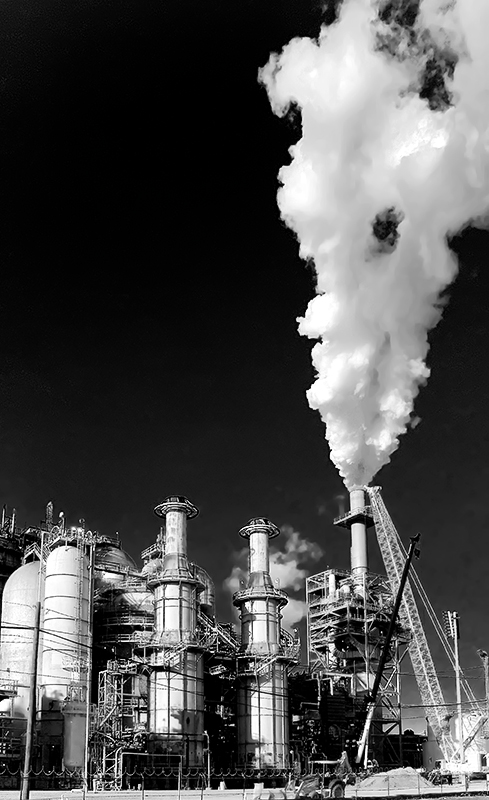The air pollution from Hurricane Harvey is really, really bad, people
After Hurricane Harvey, factories nearby released unprecedented amounts of air emissions
Nell Durfee • October 6, 2017

Texas refineries are back in action [Image Credit: FHG Photo | (CC BY 2.0)]
The late summer’s frenzy of hurricane activity has churned up some interesting finds — a fanged-tooth snake eel in Texas City, an ancient canoe in Cocoa, Fla., and at least 15 escaped coffins in Orange, La. (the other five are still MIA). However, the hurricane also left behind enough pollution to leave experts gravely concerned (pun intended).
Though the water pollution is certainly nothing to sneeze at, the air pollution has been receiving more attention for its ability to harm large numbers of unsuspecting residents. During and after the hurricane hit, environmental watchdogs such as Air Alliance Houston estimate that industrial plants around Houston released 4.6 million pounds of airborne emissions. ExxonMobil says that two of its plants were damaged, releasing about 1300 pounds of sulfur dioxide, which can harm lungs and cause breathing difficulties. The EPA’s guidelines insist that sulfur dioxide emissions should not rise above 75 parts per billion in one hour, meaning that these emissions are already hundreds of times above the recommended levels of air pollution.
Another company, the Formosa Point Comfort Plant, released some 1.3 million pounds of unspecified air pollutants, according to The New York Times. All told, these emissions have wreaked havoc on the health of Texas residents, and might cause problems for years to come. The Environmental Protection Agency (EPA), however, expressed little concern about the release of pollutants into the Houston air. On Sept. 3, the day the storm dissipated, the EPA stated: “Of the available air monitoring data collected from Aug. 24-Sept. 2, all measured concentrations were well below levels of health concern. Monitors are showing that air quality at this time is not concerning, and residents should not be concerned about air quality issues related to the effects of the storm.” These pollutant concentrations may not have perturbed the EPA, but other organizations still measured noxious chemicals in the air. The emissions contained benzene, a potent carcinogen, as well as the less common but still dangerous ethylbenzene, hexane, toluene, and xylene, according to NPR. What’s more, experts interviewed by CNN said that the emissions may have been much larger than reported, because Texas Gov. Gregg Abbott allowed industrial plants to not report emissions during the storm in order to speed up recovery efforts.
The biggest problem with the out-of-control emissions is that residents can only occasionally smell, but not see the threats, and often don’t know that what they’re experiencing is dangerous until they’re already breathing the toxic air. The cheapest houses are often the ones close to the factories, and these locations suffer much higher levels of disease. In this case, the pollution spread to more people than usual, and in much higher doses. ExxonMobil released an unprecedented slew of chemicals after their refineries were damaged in the storm, prompting locals to complain of an “unbearable chemical smell,” according to The Washington Post. Many residents reported experiencing nausea and headaches, typical symptoms of benzene and carcinogen exposure. Over time, these exposures can result in respiratory diseases such as asthma and cancer. Recently, air pollution in general has been linked to far more diseases than previously thought, including obesity and heart disease.
In case air pollution wasn’t a big enough scare, the water is also hazardous. Rising flood waters in Houston precipitated a ghastly scene, inundating local sewage treatment plants and allowing raw sewage to leak into people’s homes. Since the EPA and other local environmental testing facilities were not investigating the clearly contaminated water, the New York Times performed its own tests and discovered rampant E. coli, as well as heavy metals and mercury. Mold will almost certainly be an issue in most people’s homes. One woman even succumbed to a rare flesh-eating bacteria, contracted from flood waters in her home.
Although the media moved on to the hurricanes ravaging Fla. and Puerto Rico, environmental pollution won’t just go away. These issues are reminders that government agencies and others need to continue to be responsive to the needs of the people, and stick around for years after the disaster to monitor exposure and symptoms. The head of the Federal Emergency Management Agency (FEMA), Brock Long, has already resigned himself to this reality. After observing the damage in Houston, Long admitted during a nationally televised CNN interview that “FEMA is going to be there for years.”